I got fed up with trying to use stepper motors and small DC motors then needing to put doublers and triplers on them to get the voltage up. So I decided to make my own alternator. I mean, people do it all the time, right? I didn't know that the RACA was considered somewhat experimental.
I don't have access to a machine shop lately, so the only power tool used was the drill at the left side of the first picture. Ok, I didn't saw the wood by hand, but I could have. I wanted to use commonly available materials, perferably free. I've taken several physics courses, but never paid much attention to the magnetism parts.
OK, so this is my first alternator, with 1 test coil.
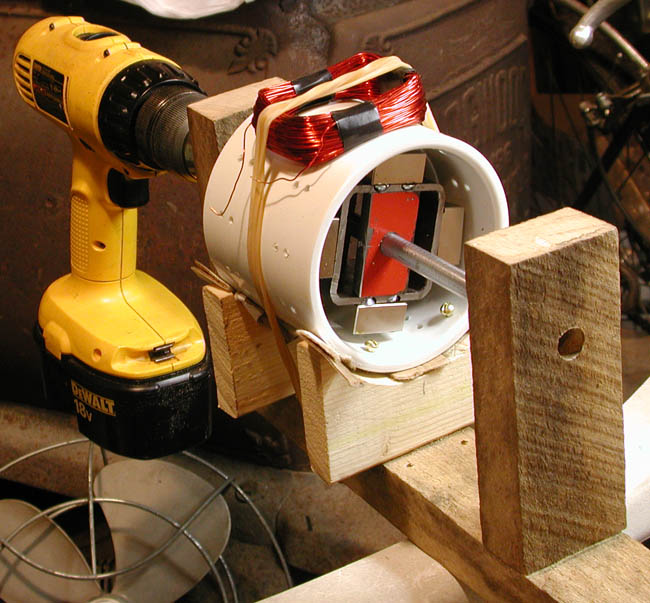
The base and the bearing supports are 1 x 2 inch oak. The shaft is 3/8" cold rolled steel from a local Aubuchon store which I chucked in the drill and cleaned up with a file and emery paper to get the bearings on. The bearings are from American Science and Surplus at $2.50/pair. The body of the rotor is 2 inch square tubing which came from the dump as part of some exercise equipment. The red pieces supporting the square tubing are 1/4 inch steel, also from the dump. The white cylinder around the whole thing is a 3 inch PVC drain pipe coupling from the local Home Depot. The cradle pieces under it are cut from spruce furring strip, also from Home Depot. The fan blade mounts where the drill is.
The magnets here are 2 x 1 x 1/2 inch Neo, I forget what grade. The coil is 150 turns of #22 wire wound on a 1.5 x 2 inch form. There are holes in the pipe that I drilled on lines 30 degrees apart. My original plan was to use 12 coils, and I was going to hitch the coils on with nylon monofilament by running it through the holes. Now the holes are mostly useful for measuring since they're 30 degrees or about 1 inch apart.
This is the rotor, shaft and bearings unmounted.
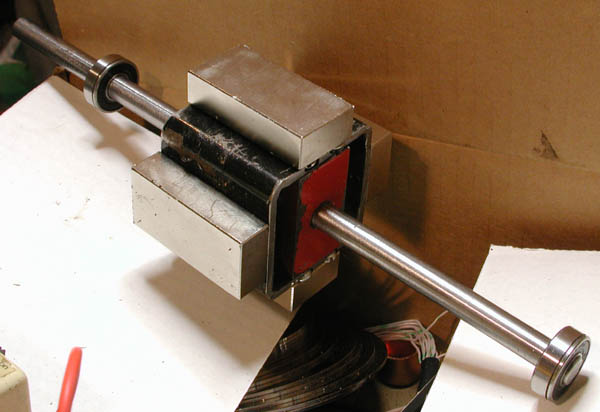
This is one of my high-tech bearing mounts:
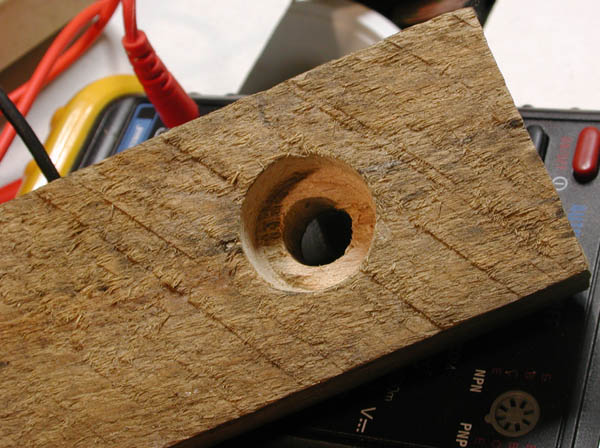
The only tool I bought for this was a 7/8 hole saw to fit the bearings. I drilled holes into the oak to a saw depth of about 1/2 inch, letting the pilot drill go on through. Then I turned it over and drilled out the pilot holes to about 7/16 to let the shaft stick through. Then I turned it back over and used a narrow wood chisel to clean out the last of the wood in the hole and leave a fairly flat bottom.
This is a shot of mostly the rotor:
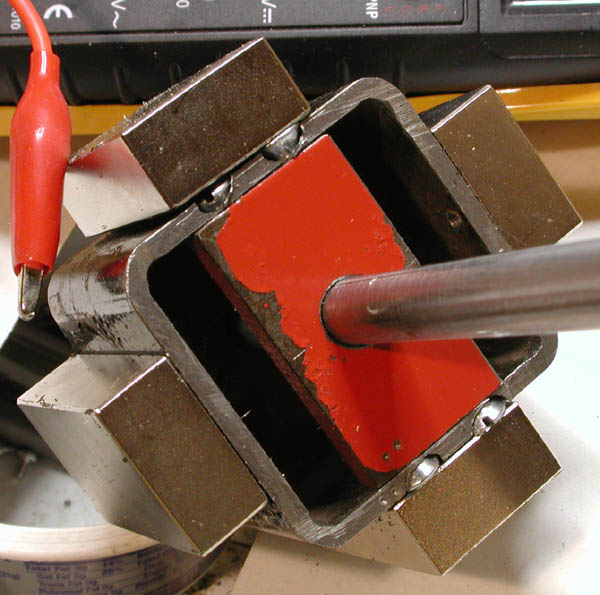
This makes the flaws easier to see. I didn't build this for such big magnets, I only added them later to try to get more voltage. The chunk of square tubing is 2 inches long and so are the magnets. I had to replace my round head screws with flat heads and try to countersink them. The holes are only about 1/8 inch from the ends, so trying to countersink them (with a drill bit) chewed out steel on the ends but didn't get the heads in far enough. Here you can see that the upper magnet is held away from the square tubing by the screw heads. This also makes the centering within the plastic tubing more critical, which is why it has shims under it and the brass screws holding it are loose. It fit fine with the original magnets, but starting hitting on the top with the bigger ones. The big ones also cover up my setscrew holes. The alligator clip just wanted to be near the magnet.
This is one of the original magnets, a Neo from a big hard drive sitting on top of a pair of the current ones.
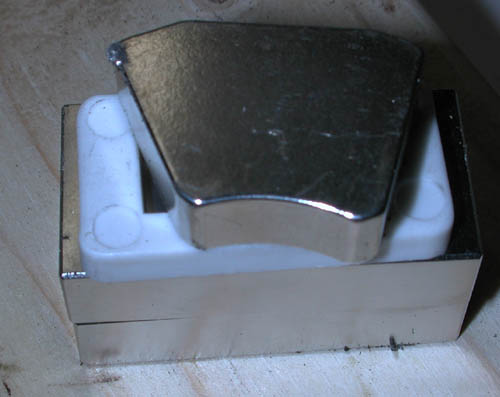
Using these bigger ones increased the voltage almost 20%, but I don't think it was worth it.
This is an idea for the next one, if I build another this way. I'm trying to find existing things that might give good balance. I want to build an alternator of some sort for a small hydro runner that turns at 2000 - 3000 RPM.
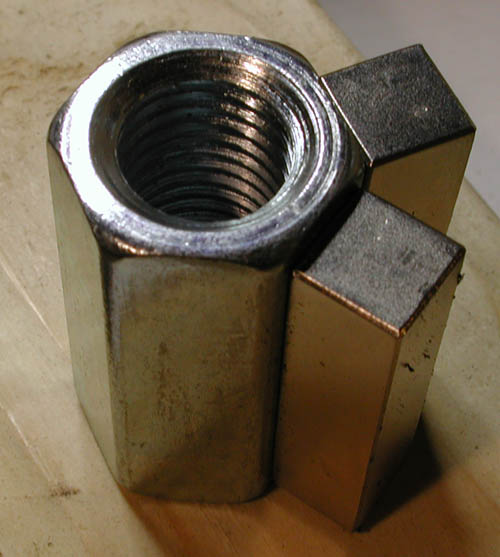
This is a couple of 1/2 x 1/2 x 2 Neos on a coupling nut for 3/4 inch rod that I found at Home Depot for about $1.30. I've got some stuff that I think I can mount these onto a shaft with. Yes, I've actually got 6 of the magnets.
I'm fairly new to taking pictures of a scope screen, but even so I've taken better ones than these.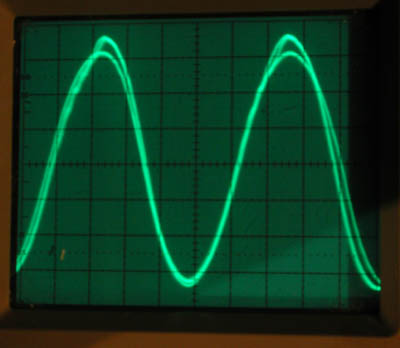
This was taken with the coil shown at about 500 RPM. The scale is 0.5 volts per division. A wide coil like this gives me a reasonable sine wave. The camera exposure time was long enough for a few scope sweeps, so here they're stacked up on each other. I don't know if the difference in the positive peak heights is real or not, or what would have caused it. Looks like about 3.2 volts peak-peak or about 3.2/2.8 = 1.1 volts RMS. Meter said 1.1, I think.
This is with a narrower coil.
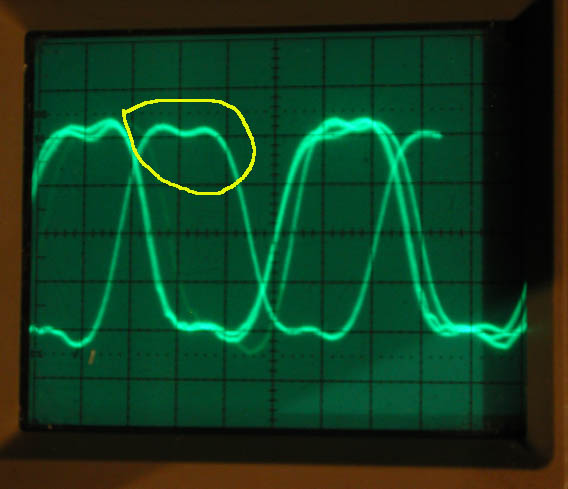
The picture's almost useless because of trigger jitter in the scope moving the traces around. It was cold out there and getting late so I didn't try for a better picture. If you look at the waveform top circled in yellow though, you'll see an odd double peak effect. My first coil was only a little bit wider than one of the hard drive magnets, and this effect was even more pronounced. This coil is about 1 inch or 30 degrees wide. When I got up to 2 inches or 60 degrees this double peaking went away. This is not the same vertical scale as above, and this coil is only about 18 turns. The scope has a focus problem, and so does the camera.
I had expected to use coils a little wider than the magnets, but I guess because there are only 4 magnets the flux spreads out and I need wider ones. I was hoping to fit 12 around the pipe and put 4 in series in each phase. Now I'm not sure what I'll do. The coil above is getting too thick to stack and make overlapping ones, at least it probably is. I've got a spool of #26 wire ordered which should make thinner coils, but even twice as many turns isn't going to give me enough voltage. And yes, I have the magnets N-S-N-S facing out.
I'm trying to get about 18 volts out of this to charge a 12 volt battery with a couple hundred feet of wire and a PB137ACV regulator which has a 1.5 volt dropout voltage. So I'm figuring like 18/1.73 = 10.4 (RMS?) divided by however many coils I put in series. I'm not even close. On a windy day with my 20 inch fan blade on, I was getting 1.5 volts RMS on a good gust. I'm getting a little over 200 MA short circuit current, I think. My meter's being strange and I have to read it on the 200 MA scale, which is getting maxed out about when the drill trigger is getting maxed out at 500 RPM.
Looking at possible problems, there is some flux leakage into the square tubing. Last time I checked (with the smaller magnets on) I could feel a little attraction inside the box with a screwdriver. There's probably a little more with the bigger magnets. Air gap: yes, air and plastic combined amounts to at least 3/8 inch in places. This coupling has a sidewall about 1/4 inch thick, and it's also got a ridge inside for the pipes you're joining to butt up against. I could try to cut or file it off, but then I'd need shims under the magnets to take advantage of the change. With the original magnets I probably could have used a piece of 3 inch pipe to get a better fit, I just didn't want to buy a 10 foot piece to get 4 or 5 inches. The coupling is a little bigger diameter, but cheap.
So since I'm waiting for wire anyway and I just found Ghurd's neat box fan conversion for a motor that looks a lot like one I've got, that's probably where I'm going next. Maybe I can use my hard drive magnets in that. Back to motors that someone else made. I'll probably get back to the hydro about February and have to dig through 3 feet of snow to find my penstock.
Alan